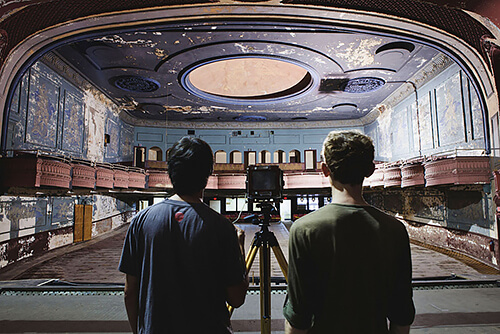
Source: Edwynn Houk Gallery
From the 60's, TV, multiplexes and urban crisis made them obsolete. During the following decades, these theaters were either modernized, transformed into adult cinemas or they closed, one after the other; many of them were simply demolished.
About Gunkanjima (2008-2012)
In the South China Sea, 15 kilometers off the southwest coast of Nagasaki among the thousands of verdant landmasses that surround Japan, lies a mysterious island. With the geometric silhouette of a dark gray hull, perforated by hundreds of small windows, the island resembles a battleship. As one moves closer, approaching by sea, the figure takes shape again and the ghost ship turns into a block of concrete surrounded by a high wall on which waves crash - the island looks like a Japanese version of Alcatraz. Only 40 years ago, this tiny island was home to one of the most remarkable mining towns in the world and maintained the highest population density in the world.
During the wave of industrialisation in the nineteenth century, a coal seam was discovered on the tiny Hashima island. In 1890 the Mitsubishi Corporation opened a mine on the island. For decades coal production sustained Japan's modernisation and helped establish its position as an industrialised nation and imperial power. Workers settled on the island and the population increased. Mine slag was used to expand the surface of the colony; piling up on itself like an ant hill. The small mining town quickly became an autonomous modern settlement (with apartment buildings, a school, hospital, shrine, retail stores and restaurants) which mimicked the other settlements on the Nippon archipelago. One multi-storied concrete apartment block with its brutal and rational style followed another, until the tiny island became the most densely populated place in the world per square meter with over 5,000 inhabitants in the 1950s.
About The Ruins of Detroit (2005-2010)
At the end of the XIXth Century, mankind was about to fulfill an old dream. The idea of a fast and autonomous means of displacement was slowly becoming a reality for engineers all over the world. Thanks to its ideal location on the Great Lakes Basin, the city of Detroit was about to generate its own industrial revolution. Visionary engineers and entrepreneurs flocked to its borders.
In 1913, up-and-coming car manufacturer Henry Ford perfected the first large-scale assembly line. Within few years, Detroit was about to become the world capital of automobile and the cradle of modern mass-production. For the first time of history, affluence was within the reach of the mass of people. Monumental skyscapers and fancy neighborhoods put the city's wealth on display. Detroit became the dazzling beacon of the American Dream. Thousands of migrants came to find a job. By the 50's, its population rose to almost 2 million people. Detroit became the 4th largest city in the United States.